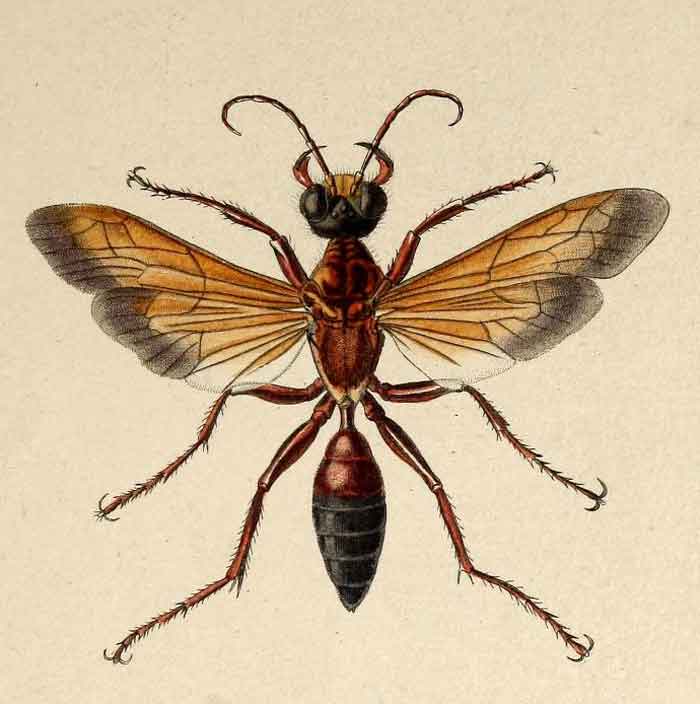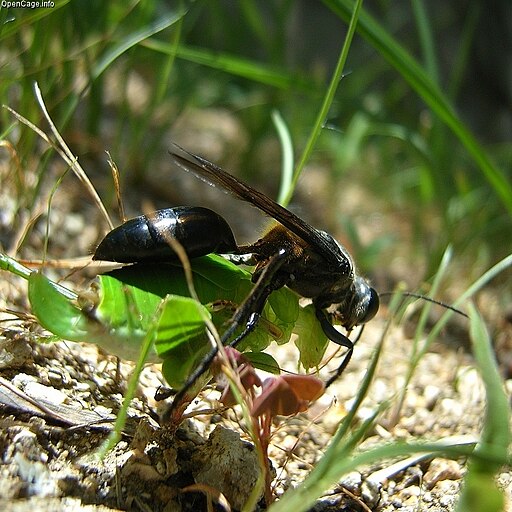Superregnum: Eukaryota
Regnum: Animalia
Subregnum: Eumetazoa
Cladus: Bilateria
Cladus: Nephrozoa
Cladus: Protostomia
Cladus: Ecdysozoa
Cladus: Panarthropoda
Phylum: Arthropoda
Subphylum: Hexapoda
Classis: Insecta
Cladus: Dicondylia
Subclassis: Pterygota
Cladus: Metapterygota
Infraclassis: Neoptera
Cladus: Eumetabola
Cladus: Endopterygota
Superordo: Hymenopterida
Ordo: Hymenoptera
Subordo: Apocrita
Superfamilia: Apoidea
Familia: Sphecidae
Tribus: Sphecini
Subtribus: Sphecina
Genus: Sphex
Species: S. abyssinicus – S. ahasverus – S. alacer – S. antennatus – S. argentatissimus – S. argentatus – S. argentinus – S. ashmeadi – S. atropilosus – S. basilicus – S. bilobatus – S. bohemanni – S. brachystomus – S. brasilianus – S. brevipetiolus – S. caelebs – S. caeruleanus – S. caliginosus – S. camposi – S. carbonarius – S. carbonarius (Smith) – S. carbonicolor – S. castaneipes – S. cinerascens – S. cognatus – S. confrater – S. corporosus – S. cristi – S. cubensis – S. darwinensis – S. decipiens – S. decoratus – S. deplanatus – S. diabolicus – S. dorsalis – S. dorycus – S. ephippium – S. ermineus – S. erythrinus – S. ferrugineipes – S. finschii – S. flammeus – S. flavipennis – S. flavovestitus – S. formosellus – S. fortunatus – S. fumicatus – S. fumipennis – S. funerarius – S. gaullei – S. gisteli – S. gilberti – S. gracilis – S. guatemalensis – S. habenus – S. haemorrhoidalis – S. hirtipes – S. ichneumoneus – S. incomptus – S. imporcatus – S. ingens – S. inusitatus – S. jamaicensis – S. jansei – S. jucundus – S. kolthoffi – S. lanatus – S. latilobus – S. latreillei – S. latro – S. leuconotus – S. libycus – S. lucae – S. luctuosus – S. madasummae – S. malagassus – S. mandibularis – S. maximiliani – S. melanocnemis – S. melanopus – S. melas – S. mendozanus – S. mimulus – S. mochii – S. modestus – S. muticus – S. neavei – S. neoumbrosus – S. nigrohirtus – S. nitidiventris – S. nudus – S. observabilis – S. opacus – S. optimus – S. oxianus – S. paulinierii – S. pensylvanicus – S. permagnus – S. peruanus – S. praedator – S. pretiosus – S. prosper – S. pruinosus – S. resinipes – S. resplendens – S. rex – S. rhodosoma – S. rufinervis – S. rufiscutis – S. rugifer – S. satanas – S. schoutedeni – S. schrottkyi – S. semifossulatus – S. sericeus – S. servillei – S. solomon – S. stadelmanni – S. staudingeri – S. subhyalinus – S. subtruncatus – S. tanoi – S. taschenbergi – S. tepanecus – S. texanus – S. tinctipennis – S. tomentosus – S. torridus – S. vestitus – S. walshae – S. wilsoni
Name
Sphex Linnaeus, 1758
Type species: Sphex flavipennis Fabricius, 1793
Synonyms
Sphaex Scopoli, 1772:122
Ammobia Billberg, 1820:105
Proterosphex Fernald, 1905:163
Fernaldina Bohart & Menke, 1963:130
Sphex argentatus
References
Dörfel, T.H. & Ohl, M. 2015. A revision of the Australian digger wasps in the genus Sphex (Hymenoptera, Sphecidae). Zookeys, 521: 1–104. DOI: 10.3897/zookeys.521.5995 Full article Reference page.
Vernacular names
English: Digger Wasps

Sphex paulinierii
Wasps of the genus Sphex (commonly known as digger wasps) are cosmopolitan predators that sting and paralyze prey insects. Sphex is one of many genera in the old digger wasp family Sphecidae (sensu lato), though most apart from the Sphecinae have now been moved to the family Crabronidae.[1] There are over 130 known Sphex species.
Behaviour
In preparation for egg laying, they construct a protected "nest" (some species dig nests in the ground, while others use pre-existing holes) and then stock it with captured insects. Typically, the prey are left alive, but paralyzed by wasp toxins. The wasps lay their eggs in the provisioned nest and the wasp larvae feed on the paralyzed insects as they develop.
The great golden digger wasp (Sphex ichneumoneus) is found in North America. The developing wasps spend the winter in their nest. When the new generation of adults emerge, they contain the genetically programmed behaviors required to carry out another season of nest building. During the summer, a female might build as many as six nests, each with several compartments for her eggs. The building and provisioning of the nests takes place in a stereotypical, step-by-step fashion.
Sphex has been shown, as in some Jean Henri Fabre studies,[2] not to count how many crickets it collects for its nest. Although the wasp instinctively searches for four crickets, it cannot take into account a lost cricket, whether the cricket has been lost to ants or flies or simply been misplaced. Sphex drags its cricket prey towards its burrow by the antennae; if the antennae of the cricket are cut off, the wasp would not think to continue to pull its prey by a leg.
The navigation abilities of Sphex were studied by the ethologist Niko Tinbergen.[3] Richard Dawkins and Jane Brockmann later studied female rivalry over nesting holes in Sphex ichneumoneus.[4]
Uses in philosophy
Some writers in the philosophy of mind, most notably Daniel Dennett, have cited Sphex's behavior for their arguments about human and animal free will.[5]
Some Sphex wasps drop a paralyzed insect near the opening of the nest. Before taking provisions into the nest, the Sphex first inspects the nest, leaving the prey outside. During the inspection, an experimenter can move the prey a few inches away from the opening. When the Sphex emerges from the nest ready to drag in the prey, it finds the prey missing. The Sphex quickly locates the moved prey, but now its behavioral "program" has been reset. After dragging the prey back to the opening of the nest, once again the Sphex is compelled to inspect the nest, so the prey is again dropped and left outside during another stereotypical inspection of the nest. This iteration can be repeated several times without the Sphex changing its sequence; by some accounts, endlessly. Dennett's argument quotes an account of Sphex behavior from Dean Wooldridge's Machinery of the Brain (1963).[6] Douglas Hofstadter[7] and Daniel Dennett[8] have used this mechanistic behavior as an example of how seemingly thoughtful behavior can actually be quite mindless, the opposite of free will (or, as Dennett described it, sphexishness).
Philosopher Fred Keijzer challenges this use of Sphex, citing experiments in which behavioral adaptations are observed after many iterations. Keijzer sees the persistence of the Sphex example in cognitive theory as an indication of its rhetorical usefulness, not its factual accuracy.[9] Of course, the repeated inspection of a disturbed nest may very well be an adaptive behavior, thus diminishing the aptness of Hofstadter's metaphor. As he concludes, "There is no reason for humans to remain stuck in an endless behavioral loop when wasps don’t."[10]
Species
Sphex argentatus
File:Sphex funerarius mit Beute.ogvPlay media
Sphex funerarius with prey
The genus Sphex contains 132 extant species:[11]
Sphex abyssinicus (Arnold, 1928)
Sphex afer Lepeletier de Saint Fargeau, 1845
Sphex ahasverus Kohl, 1890
Sphex alacer Kohl, 1895
Sphex antennatus F. Smith, 1856
Sphex argentatissimus Dörfel and Ohl, 2015
Sphex argentatus Fabricius, 1787
Sphex argentinus Taschenberg, 1869
Sphex ashmeadi (Fernald, 1906)
Sphex atropilosus Kohl, 1885
Sphex basilicus (R. Turner, 1915)
Sphex bilobatus Kohl, 1895
Sphex bohemanni Dahlbom, 1845
Sphex brachystomus Kohl, 1890
Sphex brasilianus Saussure, 1867
Sphex brevipetiolatus Dörfel and Ohl, 2015
Sphex caelebs Dörfel and Ohl, 2015
Sphex caeruleanus Drury, 1773
Sphex caliginosus Erichson, 1849
Sphex camposi Campos, 1922
Sphex carbonicolor Van der Vecht, 1973
Sphex castaneipes Dahlbom, 1843
Sphex cognatus F. Smith, 1856
Sphex confrater Kohl, 1890
Sphex corporosus Dörfel and Ohl, 2015
Sphex cristi Genaro in Genaro & Juarrero, 2000
Sphex cubensis (Fernald, 1906)
Sphex darwinensis R. Turner, 1912
Sphex decipiens Kohl, 1895
Sphex decoratus F. Smith, 1873
Sphex deplanatus Kohl, 1895
Sphex diabolicus F. Smith, 1858
Sphex dorsalis Lepeletier de Saint Fargeau, 1845
Sphex dorycus Guérin-Méneville, 1838
Sphex ephippium F. Smith, 1856
Sphex ermineus Kohl, 1890
Sphex erythrinus (Guiglia, 1939)
Sphex ferrugineipes W. Fox, 1897
Sphex finschii Kohl, 1890
Sphex flammeus Dörfel and Ohl, 2015
Sphex flavipennis Fabricius, 1793
Sphex flavovestitus F. Smith, 1856
Sphex formosellus Van der Vecht, 1957
Sphex fortunatus Dörfel and Ohl, 2015
Sphex fumicatus Christ, 1791
Sphex fumipennis F. Smith, 1856
Sphex funerarius Gussakovskij, 1934 – Golden Digger Wasp
Sphex gaullei Berland, 1927
Sphex gilberti R. Turner, 1908
Sphex gracilis Dörfel and Ohl, 2015
Sphex gisteli Strand, 1916
Sphex guatemalensis Cameron, 1888
Sphex habenus Say, 1832
Sphex haemorrhoidalis Fabricius, 1781
Sphex ichneumoneus (Linnaeus, 1758) – Great Golden Digger Wasp
Sphex imporcatus Dörfel and Ohl, 2015
Sphex incomptus Gerstaecker, 1871
Sphex ingens F. Smith, 1856
Sphex inusitatus Yasumatsu, 1935
Sphex jamaicensis (Drury, 1773)
Sphex jansei Cameron, 1910
Sphex jucundus Dörfel and Ohl, 2015
Sphex kolthoffi Gussakovskij, 1938
Sphex lanatus Mocsáry, 1883
Sphex latilobus Dörfel and Ohl, 2015
Sphex latreillei Lepeletier de Saint Fargeau, 1831
Sphex latro Erichson, 1849
Sphex leuconotus Brullé, 1833
Sphex libycus Beaumont, 1956
Sphex lucae Saussure, 1867
Sphex luctuosus F. Smith, 1856
Sphex madasummae Van der Vecht, 1973
Sphex malagassus Saussure, 1890
Sphex mandibularis Cresson, 1869
Sphex maroccanus Schmid-Egger, 2019
Sphex maximiliani Kohl, 1890
Sphex melanocnemis Kohl, 1885
Sphex melanopus Dahlbom, 1843
Sphex melas Gussakovskij, 1930
Sphex mendozanus Brèthes, 1909
Sphex mimulus R. Turner, 1910
Sphex mochii Giordani Soika, 1942
Sphex modestus F. Smith, 1856
Sphex muticus Kohl, 1885
Sphex neavei (Arnold, 1928)
Sphex neoumbrosus Jha & Farooqui, 1996
Sphex nigrohirtus Kohl, 1895
Sphex nitidiventris Spinola, 1851
Sphex nudus Fernald, 1903 – Katydid Wasp
Sphex observabilis (R. Turner, 1918)
Sphex opacus Dahlbom, 1845
Sphex optimus F. Smith, 1856
Sphex oxianus Gussakovskij, 1928
Sphex paulinierii Guérin-Méneville, 1843
Sphex pensylvanicus Linnaeus, 1763 – Great Black Wasp
Sphex permagnus (Willink, 1951)
Sphex peruanus Kohl, 1890
Sphex praedator F. Smith, 1858
Sphex pretiosus Dörfel and Ohl, 2015
Sphex prosper Kohl, 1890
Sphex pruinosus Germar, 1817
Sphex resinipes (Fernald, 1906)
Sphex resplendens Kohl, 1885
Sphex rex Hensen, 1991
Sphex rhodosoma (R. Turner, 1915)
Sphex rufinervis Pérez, 1985
Sphex rufiscutis (R. Turner, 1918)
Sphex rugifer Kohl, 1890
Sphex satanas Kohl, 1898
Sphex schlaeflei Schmid-Egger, 2019
Sphex schoutedeni Kohl, 1913
Sphex schrottkyi (Bertoni, 1918)
Sphex semifossulatus Van der Vecht, 1973
Sphex sericeus (Fabricius, 1804)
Sphex servillei Lepeletier de Saint Fargeau, 1845
Sphex solomon Hensen, 1991
Sphex stadelmanni Kohl, 1895
Sphex staudingeri Gribodo, 1894
Sphex subhyalinus W. Fox, 1899
Sphex subtruncatus Dahlbom, 1843
Sphex tanoi Tsuneki, 1974
Sphex taschenbergi Magretti, 1884
Sphex tepanecus Saussure, 1867
Sphex texanus Cresson, 1873
Sphex tinctipennis Cameron, 1888
Sphex tomentosus Fabricius, 1787
Sphex torridus F. Smith, 1873
Sphex vestitus F. Smith, 1856
Sphex walshae Hensen, 1991
Sphex wilsoni Hensen, 1991
Sphex zubaidiyacus Augul, 2013
Fossil Species
†Sphex bischoffi Zeuner, 1931
†Sphex giganteus Heer, 1867
†Sphex obscurus Statz, 1936
References
Pulawski, Wojciech J. (31 December 2014). "FAMILY GROUP NAMES AND CLASSIFICATION" (PDF). Retrieved 19 July 2015.
Fabre, J.H. (1915/2001). The hunting wasps. New York: Dodd, Mead and Company.
Tinbergen, N. (1974). Curious naturalists (2nd Ed). Harmondsworth: Penguin.
Dawkins, Richard; Brockmann, H. Jane (1980). "Do Digger Wasps Commit the Concorde Fallacy?" (PDF). Animal Behaviour. 28: 892–896. doi:10.1016/s0003-3472(80)80149-7. Retrieved 19 July 2015.
Dennett, Daniel (1973). "Mechanism and responsibility". In T. Honderich (Ed.), Essays on freedom of action. London: Routledge.
Dean Wooldridge (1963). The Machinery of the Brain. McGraw-Hill
Hofstadter, Douglas (1985). "On the seeming paradox of mechanizing creativity". In Metamagical themas. Penguin. pp. 526–546.
Dennett, Daniel (1973). "Mechanism and responsibility". In T. Honderich (Ed.), Essays on freedom of action. London: Routledge.
Keijzer, Fred. "The Sphex story: How the cognitive sciences kept repeating an old and questionable anecdote" (PDF). Retrieved 19 July 2015.
ibid.
Pulawski, Wojciech (11 October 2021). "Sphex" (PDF). California Academy of Sciences.
Retrieved from "http://en.wikipedia.org/"
All text is available under the terms of the GNU Free Documentation License


